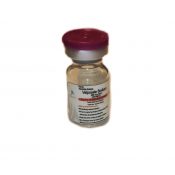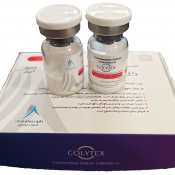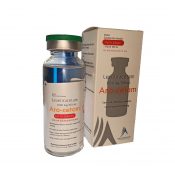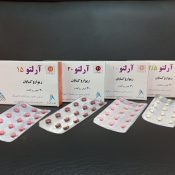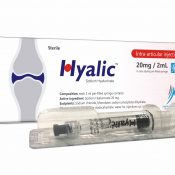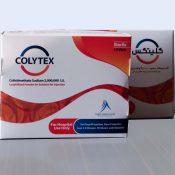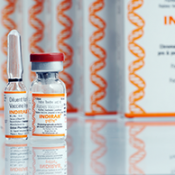
ARO-CETAM 500, Levetiracetam 100mg/ml
ARO-CETAM
500 mg/5ml
Levetiracetam 100mg/mL, 5 mL
Concentrate for solution for intravenous infusion
ARO-CETAM INJECTION MUST BE DILUTED PRIOR TO INTRAVENOUS INFUSION.
DESCRIPTION
Levetiracetam injection is an antiepileptic drug available as a clear, colorless, sterile solution (100 mg/mL) for intravenous administration.
INDICATIONS AND USAGE
Levetiracetam is used on its own in patients from 16 years of age with newly diagnosed epilepsy, to treat a certain form of epilepsy. Levetiracetam is used for the epilepsy form in which the fits initially affect only one side of the brain, but could thereafter extend to larger areas on both sides of the brain (partial onset seizure with or without secondary generalisation).
Also Levetiracetam is used with other antiepileptic medicines in :
Partial Onset Seizures
Levetiracetam is indicated as adjunctive therapy in the treatment of partial onset seizures in adults and children 1 month of age and older with epilepsy.
Myoclonic Seizures in Patients with Juvenile Myoclonic Epilepsy
Levetiracetam is indicated as adjunctive therapy in the treatment of myoclonic seizures in adults and adolescents 12 years of age and older with juvenile myoclonic epilepsy.
Primary Generalized Tonic-Clonic Seizures
Levetiracetam is indicated as adjunctive therapy in the treatment of primary generalized tonic-clonic seizures in adults and children 6 years of age and older with idiopathic generalized epilepsy.
DOSAGE AND ADMINISTRATION
Monotherapy
General dose in adults and adolescents (from 16 years of age) is between 1,000 mg and 3,000 mg each day.
Add-on therapy
Partial Onset Seizures
Adults
Initially, 500 mg IV twice daily. The dose may be increased every 2 weeks by 500 mg/dose (i.e., 1,000 mg/day) increments as needed. Max: 3,000 mg/day. There is no evidence that doses greater than 3,000 mg/day provide additional benefit.
Adolescents 16 to 17 years
Initially, 500 mg IV twice daily. The dose may be increased every 2 weeks by 500 mg/dose (i.e., 1,000 mg/day) increments as needed. Max: 3,000 mg/day. There is no evidence that doses greater than 3,000 mg/day provide additional benefit.
Children and Adolescents 4 to 15 years
Initially, 10 mg/kg/dose IV twice daily. Increase the dosage every 2 weeks by 10 mg/kg/dose (i.e., 20 mg/kg/day) increments to the recommended dosage of 30 mg/kg IV twice daily. If a patient cannot tolerate this dose, it may be reduced. In clinical trials, the mean daily dose was 44 mg/kg/day (Max: 3,000 mg/day) in this age group.
Infants and Children 6 months to 3 years
Initially, 10 mg/kg/dose IV twice daily. Increase the dose every 2 weeks by 10 mg/kg/dose (i.e., 20 mg/kg/day) increments to the recommended dose of 25 mg/kg/dose IV twice daily. If a patient cannot tolerate this dose, it may be reduced. In clinical trials, the mean daily dose was 47 mg/kg/day in this age group.
Infants 1 to 5 months
Initially, 7 mg/kg/dose IV twice daily. Increase the dose every 2 weeks by 7 mg/kg/dose (i.e., 14 mg/kg/day) increments to the recommended dose of 21 mg/kg/dose IV twice daily. In clinical trials, the mean daily dose was 35 mg/kg/day in this age group; the effectiveness of lower doses has not been studied.
Myoclonic Seizures in Patients with Juvenile Myoclonic Epilepsy
Initiate treatment with a dose of 1000 mg/day, given as twice-daily dosing (500 mg twice daily). Increase the dosage by 1000 mg/day every 2 weeks to the recommended daily dose of 3000 mg. The effectiveness of doses lower than 3000 mg/day has not been studied.
Primary Generalized Tonic-Clonic Seizures
Adults
Initially, 500 mg IV twice daily. Increase the dose every 2 weeks by 500 mg/dose (i.e., 1,000 mg/day) increments to the recommended dose of 1,500 mg IV twice daily. Max: 3,000 mg/day. It is unknown if doses lower than 3,000 mg/day are effective.
Adolescents 16 to 17 years
Initially, 500 mg IV twice daily. Increase the dose every 2 weeks by 500 mg/dose (i.e., 1,000 mg/day) increments to the recommended dose of 1,500 mg IV twice daily. Max: 3,000 mg/day. It is unknown if doses lower than 3,000 mg/day are effective.
Children and Adolescents 6 to 15 years
Initially, 10 mg/kg/dose IV twice daily. Increase the dose every 2 weeks by 10 mg/kg/dose (i.e., 20 mg/kg/day) increments to the recommended dosage of 30 mg/kg/dose IV twice daily. Max: 3,000 mg/day. It is unknown whether doses lower than 60 mg/kg/day are effective.
Switching from Oral Dosing
When switching from oral levetiracetam, the initial total daily intravenous dosage of levetiracetam should be equivalent to the total daily dosage and frequency of oral levetiracetam.
Switching to Oral Dosing
At the end of the intravenous treatment period, the patient may be switched to levetiracetam oral administration at the equivalent daily dosage and frequency of the intravenous administration.
Preparation and Administration Instructions
Levetiracetam injection is for intravenous use only and should be diluted in 100 mL of a compatible diluent prior to administration. If a smaller volume is required (e.g. pediatric patients), the amount of diluent should be calculated to not exceed a maximum levetiracetam concentration of 15 mg per mL of diluted solution. Consideration should also be given to the total daily fluid intake of the patient. Levetiracetam injection should be administered as a 15-minute IV infusion. One vial of ARO-CETAM injection contains 500 mg levetiracetam (500 mg/5 mL).
Parenteral drug products should be inspected visually for particulate matter and discoloration prior to administration whenever solution and container permit. Product with particulate matter or discoloration should not be used. Any unused portion of the ARO-CETAM injection vial contents should be discarded.
Adults
See Table 1 for the recommended preparation and administration of ARO-CETAM injection for adults to achieve a dose of 500 mg, 1000 mg, or 1500 mg.
Table 1: Preparation and Administration of levetiracetam injection for Adults
Dose Withdraw Volume Volume of Diluent Infusion Time
500 mg 5 mL (5 mL vial) 100 mL 15 minutes
1000 mg 10 mL (two 5 mL vials) 100 mL 15 minutes
1500 mg 15 mL (three 5 mL vials) 100 mL 15 minutes
For example, to prepare a 1000 mg dose, dilute 10 mL of levetiracetam injection in 100 mL of a compatible diluent and administer intravenously as a 15-minute infusion.
Pediatric Patients
When using levetiracetam injection for pediatric patients, dosing is weight-based (mg per kg).
The following calculation should be used to determine the appropriate daily dose of levetiracetam injection for pediatric patients:
Dosage Adjustments in Adult Patients with Renal Impairment
Levetiracetam dosing must be individualized according to the patient's renal function status. Recommended dosage adjustments for adults with renal impairment are shown in Table 2. Information is unavailable for dosage adjustments in pediatric patients with renal impairment. In order to calculate the dose recommended for adult patients with renal impairment, creatinine clearance adjusted for body surface area must be calculated. To do this an estimate of the patient’s creatinine clearance (CLcr) in mL/min must first be calculated using the following formula:
Then CLcr is adjusted for body surface area (BSA) as follows:
Table 2: Dosage Adjustment Regimen for Adult Patients with Renal Impairment
Group Creatinine Clearance (mL/min/1.73m2) Dosage (mg) Frequency
Normal > 80 500 to 1,500 Every 12 hours
Mild 50 – 80 500 to 1,000 Every 12 hours
Moderate 30 – 50 250 to 750 Every 12 hours
Severe < 30 250 to 500 Every 12 hours
ESRD patients using dialysis
------ 500 to 1,000* Every 24 hours1
*Following dialysis, a 250 to 500 mg supplemental dose is recommended.
COMPATIBILITY AND STABILITY
Levetiracetam injection was found to be physically compatible and chemically stable when mixed with the following diluents:
Diluents:Sodium chloride (0.9%) injection, USP Lactated Ringer’s injection, Dextrose 5% injection, USP
Other Antiepileptic Drugs: Lorazepam, Diazepam, Valproate sodium
CONTRAINDICATIONS
ARO-CETAM is contraindicated in patients with hypersensitivity to levetiracetam.
WARNINGS AND PRECAUTION
Dialysis, renal disease, renal failure, renal impairment
The clearance of levetiracetam is reduced in patients with renal disease or renal impairment and is correlated with creatinine clearance. The dosage of levetiracetam should be reduced in patients with impaired renal function.
Behavioral Abnormalities and Psychotic Symptoms
Levetiracetam may cause behavioral abnormalities and psychotic symptoms. Patients treated with Levetiracetam should be monitored for psychiatric signs and symptoms.
Somnolence and Fatigue
Levetiracetam may cause somnolence and fatigue. Patients should be monitored for somnolence and fatigue, and be advised not to drive or operate machinery until they have gained sufficient experience on Levetiracetam to gauge whether it adversely affects their ability to drive or operate machinery.
Serious Dermatological Reactions
Serious dermatological reactions, including Stevens-Johnson syndrome (SJS) and toxic epidermal necrolysis (TEN), have been reported in both pediatric and adult patients treated with levetiracetam. The median time of onset is reported to be 14 to 17 days, but cases have been reported at least four months after initiation of treatment. Recurrence of the serious skin reactions following rechallenge with Levetiracetam has also been reported. Levetiracetam should be discontinued at the first sign of a rash, unless the rash is clearly not drug- related. If signs or symptoms suggest SJS/TEN, use of this drug should not be resumed and alternative therapy should be considered.
Coordination Difficulties
Levetiracetam may cause coordination difficulties. Patients should be monitored for signs and symptoms of coordination difficulties and advised not to drive or operate machinery until they have gained sufficient experience on Levetiracetam to gauge whether it could adversely affect their ability to drive or operate machinery.
Withdrawal Seizures
Antiepileptic drugs, including Levetiracetam, should be withdrawn gradually to minimize the potential of increased seizure frequency.
Hematologic Abnormalities
Levetiracetam may cause decreases in red blood cells count (RBC), hemoglobin, hematocrit, white blood cells count (WBC), and neutrophil count.
Increase in Blood Pressure
Monitor blood pressure in neonates, infants, and children < 4 years of age receiving levetiracetam. Children 1 month to < 4 years who are treated with levetiracetam have a significantly higher risk of increased diastolic pressure. There was no overall difference in the mean diastolic blood pressure between treatment groups, and an increased risk was not observed in studies of older children or adults.
Seizure Control During Pregnancy
Physiological changes may gradually decrease plasma levels of levetiracetam throughout pregnancy. This decrease is more pronounced during the third trimester. It is recommended that patients be monitored carefully during pregnancy. Close monitoring should continue through the postpartum period especially if the dose was changed during pregnancy.
POSSIBLE SIDE EFFECTS
Like all medicines, this medicine can cause side effects, although not everybody gets them. Tell your doctor immediately, or go to your nearest emergency department, if you experience:
-weakness, feel light-headed or dizzy or have breathing difficulty, as these may be signs of a serious allergic (anaphylactic) reaction
-swelling of the face, lips, tongue and throat (Quincke’s edema)
-flu-like symptoms and a rash on the face followed by an extended rash with a high temperature, increased levels of liver enzymes seen in blood tests and an increase in a type of white blood cell (eosinophilia) and enlarged lymph nodes (Drug Reaction with Eosinophilia and Systemic
Symptoms
- symptoms such as low urine volume, tiredness, nausea, vomiting, confusion and swelling in the legs, ankles or feet, as this may be a sign of sudden decrease of kidney function
-a skin rash which may form blisters and look like small targets (central dark spots surrounded by a paler area, with a dark ring around the edge) (erythema multiforme)
-a widespread rash with blisters and peeling skin, particularly around the mouth, nose, eyes and genitals (Stevens-Johnson syndrome)
-a more severe form of rash causing skin peeling in more than 30% of the body surface (toxic epidermal necrolysis)
-signs of serious mental changes or if someone around you notices signs of confusion, somnolence (sleepiness), amnesia (loss of memory), memory impairment (forgetfulness), abnormal behavior or other neurological signs including involuntary or uncontrolled movements. These could be symptoms of an encephalopathy.
ADVERSE REACTIONS
The most frequently reported adverse reactions were nasopharyngitis, somnolence (sleepiness), headache,
fatigue and dizziness. At the beginning of the treatment or at dose increase of the side effects like sleepiness, tiredness and dizziness may be more common. These effects should however decrease over time.
Very common:
-nasopharyngitis
-somnolence (sleepiness), headache
Common:
-anorexia (loss of appetite)
-depression, hostility or aggression, anxiety, insomnia, nervousness or irritability
-convulsion, balance disorder (equilibrium disorder), dizziness (sensation of unsteadiness), lethargy (lack of energy and enthusiasm)
, tremor (involuntary trembling)
-vertigo (sensation of rotation)
-cough
- abdominal pain, diarrhoea, dyspepsia (indigestion), vomiting, nausea
-rash
-asthenia/fatigue (tiredness)
Uncommon:
-decreased number of blood platelets, decreased number of white blood cells
-weight decrease, weight increase
-suicide attempt and suicidal ideation, mental disorder, abnormal behavior, hallucination, anger, confusion,
panic attack, emotional instability/mood swings, agitation
-amnesia (loss of memory), memory impairment (forgetfulness), abnormal coordination/ataxia (impaired coordinated movements), paraesthesi
a (tingling), disturbance in attention (loss of concentration)
-diplopia (double vision), vision blurred
-elevated/abnormal values in a liver function test
-hair loss, eczema, pruritus
-muscle weakness, myalgia (muscle pain)
-injury
Rare:
-infection
-decreased number of all blood cell types
-severe allergic reactions
Quincke’s edema
-decreased blood sodium concentration
-suicide, personality disorders (behavioural problems), thinking abnormal (slow thinking, unable to concentrate)
-uncontrollable muscle spasms affecting the head, torso and limbs, difficulty in controlling movements, hyperkinesia (hyperactivity)
-pancreatitis
-liver failure hepatitis
-sudden decrease in kidney function
-skin rash, which may form blisters and looks like small targets (central dark spots surrounded by a paler area, with a dark ring around the edge) (erythema multiforme), a widespread rash with blisters and peeling skin, particularly around the mouth, nose, eyes and genitals (Stevens-Johnson syndrome), and a more severe form causing skin peeling in more than 30% of the body surface (toxic epidermal necrolysis)
-rhabdomyolysis (breakdown of muscle tissue) and associated blood creatine phosphokinase increase.
-limp or walking difficulty.
DRUG INTERACTIONS
No significant pharmacokinetic interactions were observed between levetiracetam or its major metabolite and concomitant medications via human liver cytochrome P450 isoforms, epoxide hydrolase, UDP-glucuronidation enzymes, P-glycoprotein, or renal tubular secretion.
USE IN SPECIFIC POPULATIONS
Pregnancy
Pregnancy Category C
There are no adequate and well-controlled studies in pregnant women. In animal studies, levetiracetam produced evidence of developmental toxicity, including teratogenic effects, at doses similar to or greater than human therapeutic doses. Levetiracetam should be used during pregnancy only if the potential benefit justifies the potential risk to the fetus by your doctor.
Nursing Mothers
Levetiracetam is excreted in human milk. Because of the potential for serious adverse reactions in nursing infants from levetiracetam, a decision should be made whether to discontinue nursing or discontinue the drug by your doctor, taking into account the importance of the drug to the mother.
Pediatric Use
The safety and effectiveness of levetiracetam in the adjunctive treatment of partial onset seizures in pediatric patients’ age 1 month to 16 years with epilepsy have been established. The dosing recommendation in these pediatric patients varies according to age group and is weight-based [see Dosage and Administration].
Geriatric Use
Levetiracetam is known to be substantially excreted by the kidney, and the risk of adverse reactions to this drug may be greater in patients with impaired renal function. Because elderly patients are more likely to have decreased renal function, care should be taken in dose selection, and it may be useful to monitor renal function.
Renal Impairment
Clearance of levetiracetam is decreased in patients with renal impairment and is correlated with creatinine clearance. Dosage adjustment is recommended for patients with impaired renal function and supplemental doses should be given to patients after dialysis [see Dosage and Administration].
OVERDOSAGE
• Signs, Symptoms and Laboratory Findings of Acute Overdosage in Humans
Cases of drowsiness, somnolence, agitation, and aggression, depressed level of consciousness, respiratory depression, and coma were observed with levetiracetam overdoses.
• Management of Overdose
There is no specific antidote for overdose with levetiracetam. If indicated, elimination of unabsorbed drug should be attempted by emesis or gastric lavage; usual precautions should be observed to maintain airway. General supportive care of the patient is indicated including monitoring of vital signs and observation of the patient’s clinical status.
• Hemodialysis
Standard hemodialysis procedures result in significant clearance of levetiracetam (approximately 50% in 4 hours) and should be considered in cases of overdose. Although hemodialysis has not been performed in the few known cases of overdose, it may be indicated by the patient's clinical state or in patients with significant renal impairment.
HOW SUPPLIED/STORAGE AND HANDLING
ARO – CETAM active substance is called levetiracetam. The other ingredients are: sodium acetate, glacial acetic acid,
Sodium chloride and water for injection.
ARO-CETAM (levetiracetam) 500 mg/5 mL injection is a clear, colorless, sterile solution. It is supplied in single-use 5 mL vials, available in cartons of 5 vials.
Storage
Store at below 25◦C.
Marketing Authorization Holder:
Darou Darman Arang-
Tehran-Iran
Email:info@arangpharm.com
Web site: www.arangpharm.com

